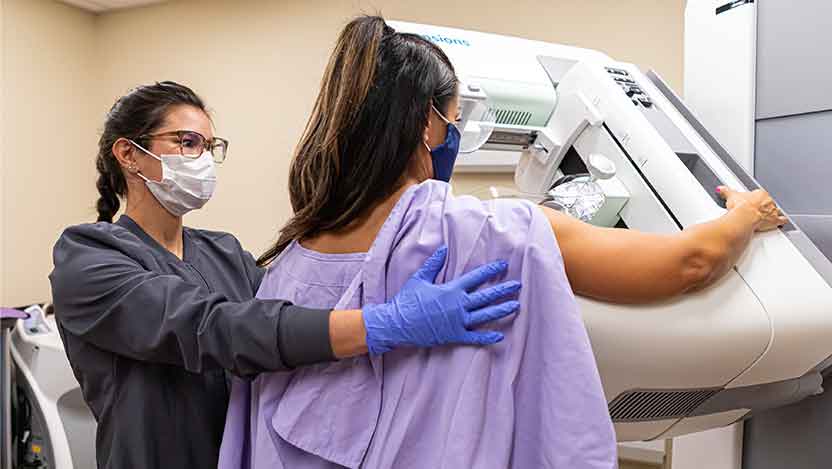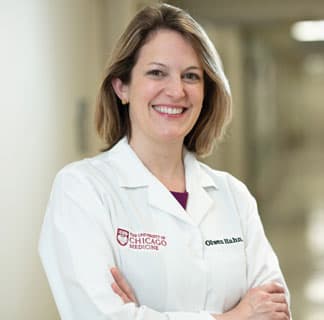What you need to know about the new mammogram recommendations

Mammograms should begin at age 40 for women at average risk of breast cancer, according to a new federal panel's recommendation.
Women with an average risk for breast cancer should have a mammogram every two years starting at age 40 rather than age 50, according to a new draft recommendation from the U.S. Preventative Services Task Force.
University of Chicago Medicine’s breast cancer experts strongly support the recommendation to start mammograms at age 40, which they’ve done for many years. They also believe people as young as 25 should have a breast cancer risk assessment with their obstetrician-gynecologist (OB-GYN) or primary care doctor. That way they can determine if they’re at high risk for the disease, and if so, can be screened sooner than age 40.
“It’s heartbreaking when a patient comes in at age 45 with a cancer that now requires intensive therapy, where maybe, if we knew about it sooner, it may not have been necessary,” said UChicago Medicine breast surgeon Sarah P. Shubeck, MD, MS.
Some specialists worry that the task force’s one-size-fits-all approach could lead to unnecessary breast MRIs, biopsies and patient anxiety. However, UChicago Medicine breast cancer experts say the benefits of early detection far outweigh the risks, and will save lives and reduce the need for intensive cancer treatments.
U.S. women have a 13% chance of developing breast cancer, Olufunmilayo I. Olopade, MD, and radiologist Kirti Kulkarni, MD, to explain this new recommendation and share key takeaways.
Why do I need a mammogram at age 40?
Shubeck: The recommendation is for patients who say, “I don’t know anything about breast cancer. How do I take care of myself?” This is how they can take control of their health. Breast cancer is incredibly common and we want to be proactive. You don’t have to have a family history to be affected. This should evoke a feeling of empowerment rather than fear. Knowledge is power.
Olopade: Every decision we make in healthcare is nuanced, but we know there’s an epidemic of women getting breast cancer between the ages of 40-49. What’s causing that epidemic? We are trying to find out. The most important thing we can do is practice evidence-based medicine. The data suggests that as you get older, you may get breast cancer. So the recommendation to have a mammogram at age 40 is a step in the right direction. Everyone should talk to their OB-GYN or primary care doctor in their 20s or 30s, so by the time they’re 40, they know if they’re at average or high risk for breast cancer.
Kulkarni: We see so many young patients with breast cancer. Ages 40 to 50 is where we see more aggressive cancers. If the patient is high-risk, a mammogram may not be enough. They may need a breast MRI. But for an average-risk woman, 40 is definitely the right time to start screening.
Who is at high risk for breast cancer?
Olopade: Risk factors differ by race and ethnicity, but Black women and Ashkenazi Jews are at high risk. So is anyone with a family history of the disease, who carries a genetic mutation such as BRCA or p53, or who has already had multiple breast biopsies.
How do I know if I have dense breasts?
Shubeck: You can't know if you have dense breasts if you’ve never had a mammogram. If you have dense breasts — which means your breasts have more glandular and fibrous tissue than fatty tissue — it is harder for radiologists to see cancer on a mammogram. That means a mammogram will be insufficient to capture and characterize what’s going on in the breast. We do a lot of supplementary imaging here at the UChicago Medicine Comprehensive Cancer Center. It’s effective because we find the cancer at a point when it’s easier to intervene.
Kulkarni: Of the screening mammograms we do, 40% are for women with dense breasts. That’s a high number. It’s a challenge for us mammographers because dense breast tissue can hide a small cancer. We have the best tools out there — 3D mammography, whole breast ultrasound and an ultrafast abbreviated breast MRI. These tests don’t replace mammograms, but they detect small invasive cancers that are difficult to see on a mammogram. There are ongoing studies (such as the WISDOM study) to personalize the best screening test and the frequency you need. That is the future.
Olopade: For most young women with dense breasts, the probability that we’ll find cancer is very low. It’s easier to see cancer on a mammogram for a 50-year-old woman who has more fatty breast tissue than a young woman with dense breasts. That’s why we don’t want to give every woman under the age of 40 a mammogram and why there are debates about mammograms.
Do I need a breast MRI?
Olopade: If you know you're at high risk at age 30, or if you have dense breasts, you should be getting a breast MRI. We are starting a national study on breast MRIs for certain women in that age group. We now have laws saying if you have dense breasts, you need to be notified after your mammogram so you can opt for additional testing.
Kulkarni: If you are at high risk for breast cancer or have dense breasts, yes, you need a breast MRI. It might be needed to catch hard-to-detect cancer before it spreads to the lymph nodes and other parts of the breast and body. If that happens, a patient must go through more chemotherapy and radiation, which is expensive, time-consuming and takes a toll on their body. The breast MRI helps radiologists look for masses, non-mass areas of enhancement and axillary, and internal mammary lymph nodes. The biology of the tumor dictates whether it’s a slow-or fast-growing tumor. Sometimes, the calcifications (in-situ cancer) can be slow-growing, but sometimes these small masses (for example, triple-negative cancer) that look like benign masses can be very fast-growing. They come up out of nowhere and have a high aggressiveness factor.
Am I likely to get a false positive on my mammogram or MRI?
Kulkarni: As a radiologist, I’ve seen a sharp drop in the number of false positives on mammograms and breast MRIs because the technology has evolved. We have really sharp images now. There are dedicated breast radiologists who have completed one year of breast imaging fellowship and have learned the nuances of interpretation and interventional skills. The amount of time the patients spend “on the scanner” is getting shorter. Plus, we use artificial intelligence and computer-assisted diagnosis with our interpretation. The number of false positive biopsies has gone down, too. In every test we do, we have newer tools and newer ways of understanding what an image can tell us about the biology and aggressiveness of the tumor. There’s a lot of research being done on that front.
Shubeck: It’s not likely, but if you get a false positive on an MRI, then it means we’ve checked it out and we’ve determined it’s not cancer. Then we make a screening plan and move forward. It’s worth the risk to find a small breast cancer before it warrants very intensive therapy.
Do I need genetic testing for breast cancer?
Kulkarni: Anyone at high risk should have genetic testing. But sometimes, women with average breast cancer risk get testing done because they’re anxious to know. And that’s fine. If they have a genetic mutation, then they can let family members know that they may be at high risk for certain cancers. We have a really good group of genetic counselors at UChicago Medicine who use different models to calculate a patient’s risk for breast cancer. It can done through a blood or saliva test.
Olopade: As a geneticist, I’m excited to talk about this. It’s important to have genetic testing because then we can look at all genetic variants that put some women at very high risk and some women at low risk. There are so many genetic variants. Now we can look at all of them in your entire genome. We want to know, who is in the extreme? Who is at low risk? Maybe they can screen every two years or three years? We want to learn how best to screen them so we don’t overdiagnose and we don’t miss the cancers.
What’s new with the WISDOM study?
Olopade: It’s still ongoing. The WISDOM study (Women Informed to Screen Depending On Measures of risk) is a personalized approach to screening. One size doesn’t fit all. We’ve already enrolled 70,000 women, including more diverse participants that UChicago Medicine has access to. We’re actually moving the enrollment age down to 30 now so we can study women at high risk for breast cancer.
Black women have the highest breast cancer death rate. What does this recommendation mean for them?
Kulkarni: We can’t say recommending mammograms at age 40 will change the story for Black women, but it will help. The problem is, despite significant progression in diagnostics, therapeutics and improvement in surgical therapies, there’s still a huge racial mortality gap and there are still women dying of breast cancer.
Shubeck: Increased screenings have moved the needle. They’ve made breast cancer outcomes better, but they’ve been differentially beneficial to certain subsets of the population. Black women still have higher mortality from breast cancer than white women. Hopefully, this recommendation will correct some of that disparity where women of color were left behind. It’s about closing the gap.
Olopade: When you look at America’s diverse population, you can see why we need to adjust how we do screenings. For example, Black women are more likely to get breast cancer under age 40 and get triple-negative breast cancer (an aggressive and deadly form) at some point in their lives. Earlier screenings are needed for them.
What are the key takeaways from all this?
Olopade: Every woman should know their risk for breast cancer. Because of the recent advancements, we have better tools and better risk prediction. About 30% of women with breast cancer do not find it on a mammogram. That’s why all the guidelines say, get the mammogram, assess the risk, and then if you’re at high risk or have dense breasts, get a breast MRI.
Shubeck: A lot of women stopped having mammograms during COVID. I hope this recommendation will empower people to reconnect with screening. We want women to understand what their risk profile is and partner with their doctors to make the right screening plan for them. Is mammogram enough? Do I need an MRI? Do I need an ultrasound? And when? And how often? Breast cancer is like a fingerprint. Each person has a different set of circumstances and we work together as a multidisciplinary program to get the right care for each patient.
Kulkarni: We need to do the risk assessment sooner, and in some cases, more frequently, because it’s not a one-size-fits-all thing. The risk for breast cancer changes over one's lifetime.

Breast Cancer Care
Our team represents expertise across the spectrum of breast cancer care: breast imaging, breast surgery, medical and radiation oncology, plastic and reconstructive surgery, lymphedema treatment, clinical genetics, pathology and nursing. Our comprehensive care approach optimizes chances of survival and quality of life.
Learn more about UChicago Medicine breast cancer care.